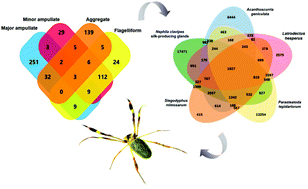当前位置:
X-MOL 学术
›
Mol. Omics
›
论文详情
Our official English website, www.x-mol.net, welcomes your
feedback! (Note: you will need to create a separate account there.)
A proteotranscriptomic study of silk-producing glands from the orb-weaving spiders.
Molecular Omics ( IF 3.0 ) Pub Date : 2019-08-05 , DOI: 10.1039/c9mo00087a José Roberto Aparecido Dos Santos-Pinto 1 , Franciele Grego Esteves , Fernando J Sialana , Milene Ferro , Roman Smidak , Lucaciu Calin Rares , Thomas Nussbaumer , Thomas Rattei , Martin Bilban , Maurício Bacci Júnior , Mario Sergio Palma , Gert Lübec
Molecular Omics ( IF 3.0 ) Pub Date : 2019-08-05 , DOI: 10.1039/c9mo00087a José Roberto Aparecido Dos Santos-Pinto 1 , Franciele Grego Esteves , Fernando J Sialana , Milene Ferro , Roman Smidak , Lucaciu Calin Rares , Thomas Nussbaumer , Thomas Rattei , Martin Bilban , Maurício Bacci Júnior , Mario Sergio Palma , Gert Lübec
Affiliation

|
Orb-weaving spiders can produce different silk fibers, which constitute outstanding materials characterized by their high strength and elasticity. Researchers have tried to reproduce the fibers of these proteins synthetically and/or by using recombinant DNA technology, but only a few of the natural physicochemical and biophysical properties have been obtained to date. Female orb-web-spiders present seven silk-glands, which synthesize the spidroins and a series of other proteins, which interact with the spidroins, resulting in silk fibers with notable physicochemical properties. Despite the recognized importance of the silk-glands for understanding how the fibers are produced and processed, the investigation of these glands is at a nascent stage. In the current study we present the assembled transcriptome of silk-producing glands from the orb-weaving spider Nephila clavipes, as well as develop a large-scale proteomic approach for in-depth analyses of silk-producing glands. The present investigation revealed an extensive repertoire of hitherto undescribed proteins involved in silk secretion and processing, such as prevention of degradation during the silk spinning process, transportation, protection against proteolytic autolysis and against oxidative stress, molecular folding and stabilization, and post-translational modifications. Comparative phylogenomic-level evolutionary analyses revealed orthologous genes among three groups of silk-producing organisms - (i) Araneomorphae spiders, (ii) Mygalomorphae spiders, and (iii) silk-producing insects. A common orthologous gene, which was annotated as silk gland factor-3 is present among all species analysed. This protein belongs to a transcription factor family, that is important and related to the development of the silk apparatus synthesis in the silk glands of silk-producing arthropods.
中文翻译:

一个蛋白质转录组学研究,从织球的蜘蛛中产生丝的腺体。
织球的蜘蛛可以产生不同的丝纤维,这些丝纤维构成了以高强度和弹性为特征的出色材料。研究人员已经尝试通过合成和/或使用重组DNA技术来复制这些蛋白质的纤维,但是迄今为止,仅获得了一些自然的物理化学和生物物理特性。雌性蜘蛛网状蜘蛛呈现七个丝腺,它们合成了蜘蛛丝蛋白和一系列其他蛋白质,这些蛋白与蜘蛛丝蛋白相互作用,从而产生具有显着理化特性的丝纤维。尽管丝绸腺体对于理解纤维的生产和加工方式具有重要意义,但对这些腺体的研究仍处于起步阶段。在当前的研究中,我们介绍了从织球的蜘蛛Nephila锁骨中提取的产丝腺的转录组,并开发了一种大规模蛋白质组学方法来对产丝腺进行深入分析。本研究揭示了迄今为止尚未描述的参与丝绸分泌和加工的蛋白质,例如防止丝绸纺丝过程中降解,运输,防止蛋白水解自溶和氧化应激,分子折叠和稳定化以及翻译后修饰等。 。比较的系统生物学水平的进化分析揭示了三类产丝生物中的直系同源基因-(i)morph形蜘蛛,(ii)扁形蜘蛛和(iii)产丝昆虫。常见的直系同源基因,被分析为丝腺因子3的细菌存在于所有被分析的物种中。该蛋白属于转录因子家族,其重要且与产丝节肢动物的丝腺中丝设备合成的发展有关。
更新日期:2019-08-05
中文翻译:

一个蛋白质转录组学研究,从织球的蜘蛛中产生丝的腺体。
织球的蜘蛛可以产生不同的丝纤维,这些丝纤维构成了以高强度和弹性为特征的出色材料。研究人员已经尝试通过合成和/或使用重组DNA技术来复制这些蛋白质的纤维,但是迄今为止,仅获得了一些自然的物理化学和生物物理特性。雌性蜘蛛网状蜘蛛呈现七个丝腺,它们合成了蜘蛛丝蛋白和一系列其他蛋白质,这些蛋白与蜘蛛丝蛋白相互作用,从而产生具有显着理化特性的丝纤维。尽管丝绸腺体对于理解纤维的生产和加工方式具有重要意义,但对这些腺体的研究仍处于起步阶段。在当前的研究中,我们介绍了从织球的蜘蛛Nephila锁骨中提取的产丝腺的转录组,并开发了一种大规模蛋白质组学方法来对产丝腺进行深入分析。本研究揭示了迄今为止尚未描述的参与丝绸分泌和加工的蛋白质,例如防止丝绸纺丝过程中降解,运输,防止蛋白水解自溶和氧化应激,分子折叠和稳定化以及翻译后修饰等。 。比较的系统生物学水平的进化分析揭示了三类产丝生物中的直系同源基因-(i)morph形蜘蛛,(ii)扁形蜘蛛和(iii)产丝昆虫。常见的直系同源基因,被分析为丝腺因子3的细菌存在于所有被分析的物种中。该蛋白属于转录因子家族,其重要且与产丝节肢动物的丝腺中丝设备合成的发展有关。











































 京公网安备 11010802027423号
京公网安备 11010802027423号